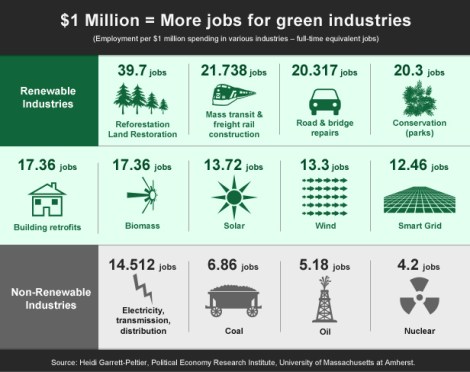With Congress and the White House considering spending scarce dollars to jump-start employment, they’ll need to get the biggest jobs bang for the buck to give Americans confidence that they’re spending our money wisely. Probably the biggest jobs generator of all, and one of the least recognized, is investing in forest and land restoration and sustainable management, with conservation, watershed projects, and park investment coming close behind.
Heidi Garrett-Peltier and Robert Pollin at The Political Economy and Research Institute of the University of Massachusetts report the following numbers for jobs created per dollar of investment.
To summarize, reforestation and restoration outperforms even the second-most jobs-intense activity analyzed by 74 percent, and conservation exceeds other major jobs alternatives, including especially new highway construction, Wall Street, and conventional energy sources like oil and nuclear.

See full jobs table here [pdf].
This means that if the government is serious about creating jobs, it’s got to pass clean energy and climate legislation and a new jobs bill that includes powerful incentives for reforestation, revegetation, sustainable forest management, and conservation.
This legislation can perform the equivalent of the Civilian Conservation Corps, the extremely popular New Deal program that put millions of people to work in forestry and conservation.
Why are forest investments such good job generators? Restoring forests (as well as rivers, wetlands, peat bogs, and prairies), requires people, which means jobs: soil scientists, tree planters, equipment operators, water engineers, and people to nurture the trees over time.
Conservation — investing in, for instance, the expansion of National Parks and other local, state, and federal recreation areas through, for instance, the Land and Water Conservation Fund — isn’t too far behind. Some of the direct jobs in this sector include park rangers, park transportation workers, and other park personnel.
Relative to other spending options, investments in forests and parks tend to go towards wages rather than capital investments — providing the greatest benefit to communities, especially in economically difficult times (since Nature largely provides the materials that go into making a tree or a prairie grow for free, you don’t need the same kind of capital as you do for, say, building a highway).
The actual jobs impact of forest investment is actually significantly greater than what’s represented in the above table. A variety of other studies have analyzed job creation through conservation and found dramatic indirect effects. Expand a national park, national forest, river or local recreation area, and spending on and employment in outdoor recreation — everything from birdwatching and hiking to fishing and hunting – is dramatically increased.
A 2006 report for the Outdoor Industry Association found that the availability of active outdoor recreation generated $289 billion in retail sales and services across the United States, with a total of 6.5 million jobs supported by the recreation economy overall. Other reports focusing on roadless areas, national forests, and privately-owned forests have found similar results: the National Alliance of Forest Owners [pdf] reports that every hundred acres of privately owned forests supports eight jobs and the FAO reported last year that investing in sustainable forestry management could create ten million new, good-paying jobs worldwide.
Of course, jobs aren’t the only reason restoration and conservation are a good idea: forests and other wildlands suck pollution out of the air, provide wildlife habitat, and recreational opportunities — allowing America to put people back to work, and giving them somewhere beautiful to go when they’re done.
Olivier Jarda, a policy associate at the Center for International Policy, assisted with the research for this post.




